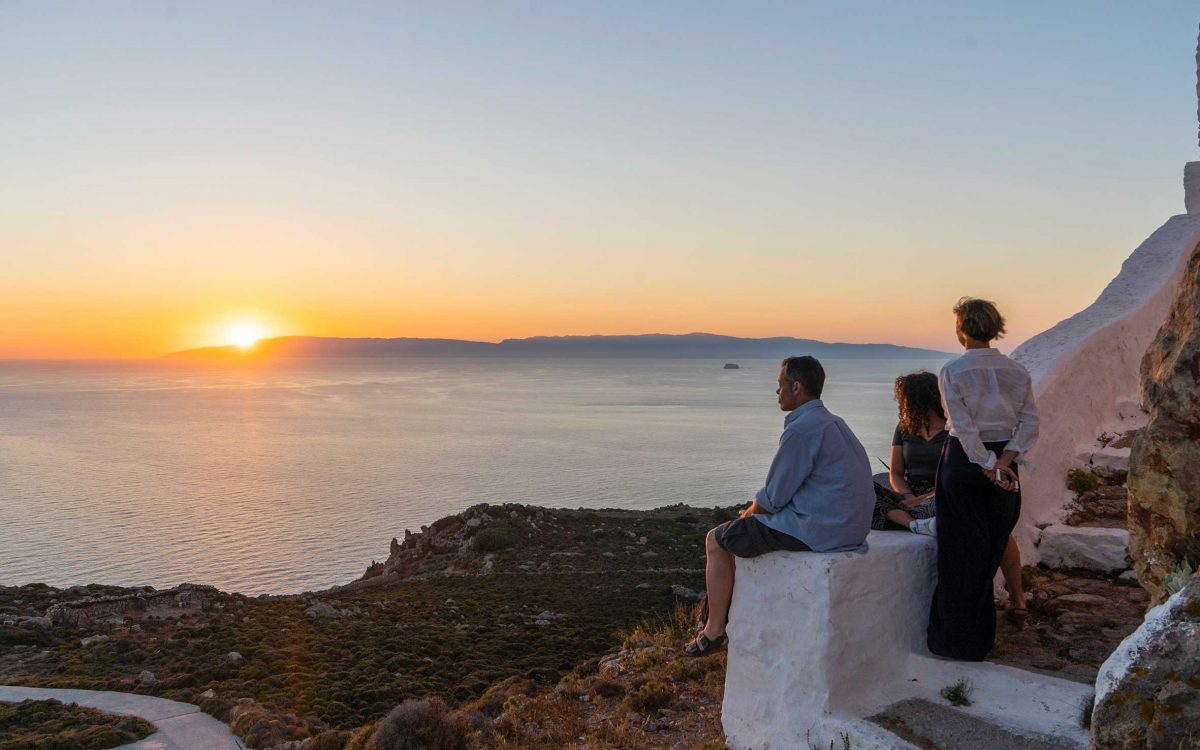The house I am staying in is an old captain’s house. From the top floor, the shipowner could observe things in the port at Skala, and be able to see whether Nikolios is working or slacking off by his boat. It was 1088 when Emperor Alexios I Komninos granted the monastery with his imperial bull the license to trade at sea. Since then, Patmos has been inextricably linked with Greek naval history.
Some of the furniture in the house, such as the mirrors and consoles, were brought back by the shipping magnates of the times from their travels to the West. Other pieces, like wooden couches, tables, and chairs, are locally made by master carpenters. On the walls hang platters with naturalistic motifs, and one – my favorite – has painted on it a crown. These were only brought down for formal occasions, and serve mainly as displays of wealth.
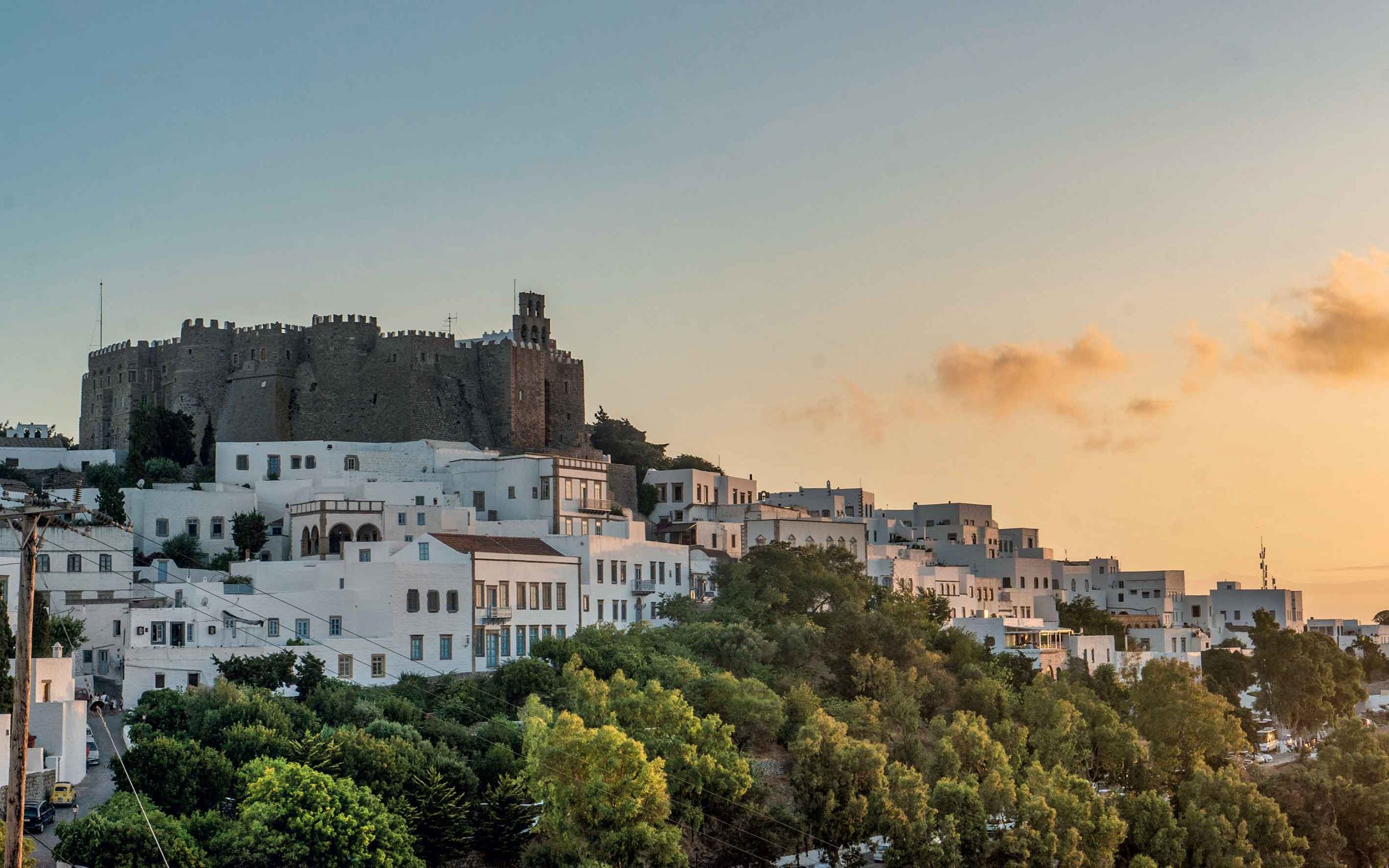
© Perikles Merakos
Over 500 mansions like this survive in Chora. Half of them, and perhaps more, have passed into foreign hands. The monastery still owns a few of them, but mostly they are owned by enlightened foreigners – or equally enlightened Greeks. Given that the law on preservation forbids any external alterations, any deviations from the historical design are to be found in the interiors, where walls are often knocked down to enlarge the original small rooms and create more spacious bedrooms.
These interventions aside, the tradition has been preserved, which is a miracle in a country with a history of unregulated building. The designation of the monastery of St John the Divine as the UNESCO World Heritage Monument in 1999 safeguarded the unspoiled character of the town, put a stop to the ambitions developers, and closed the door to the frivolous visitors looking to import less reverent lifestyles.
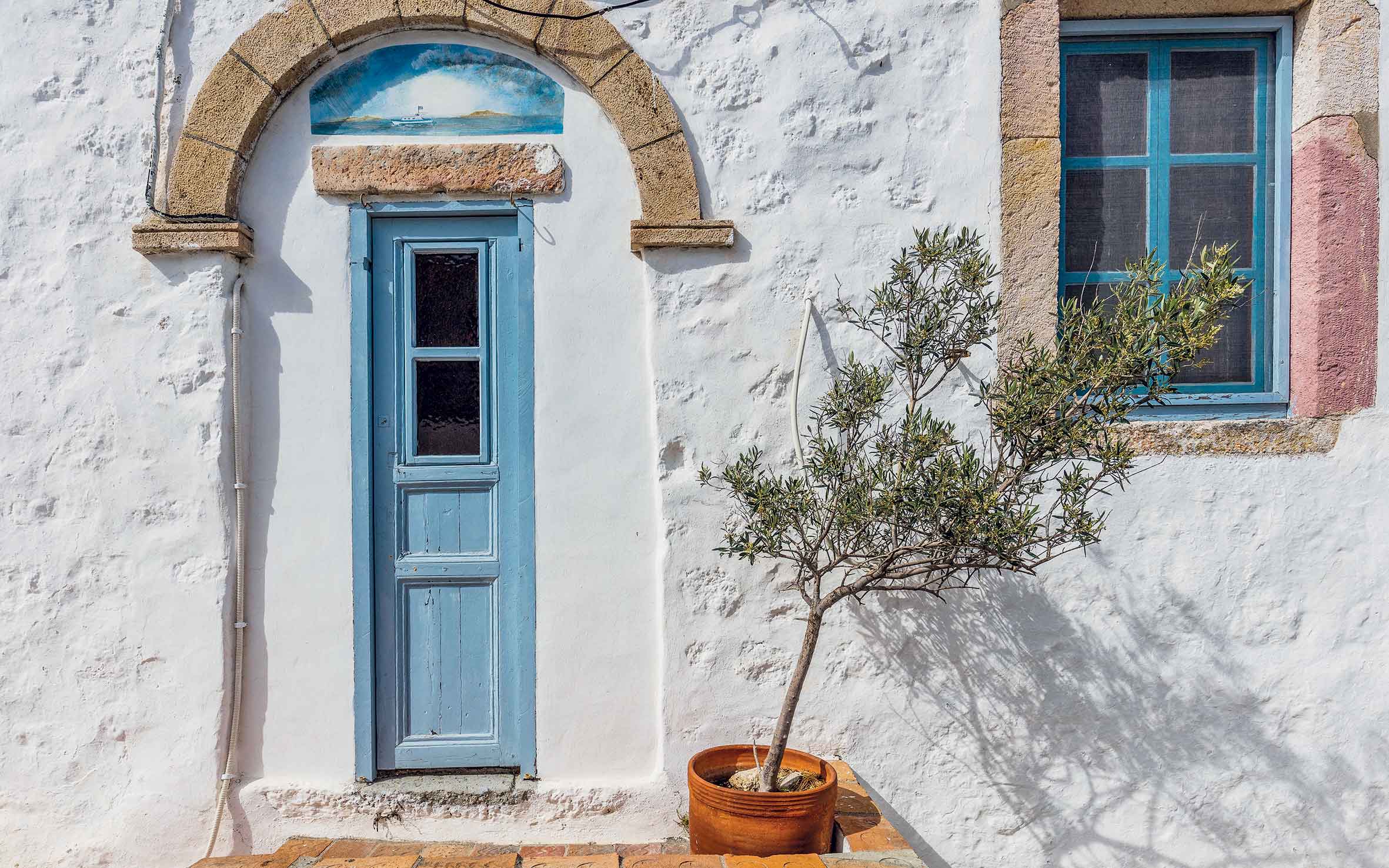
© AFP/VISUALHELLAS.GR
The time is 7:00 and I am searching my cell phone for the app showing the location of the boat I am going to meet. The Blue Star is currently off Leros. I estimate that this gives me enough time to get to the port on foot. The old path is intersected by the modern road at several points, but for the most part maintains its authenticity. The enchanting view causes me to stumble among the stones, so I decide to focus instead on the ground. A little later I lift my gaze again, startled by loud birdsong. Among the branches of an almond tree I spot two bird nests, with the “parents” darting about to feed their chicks.
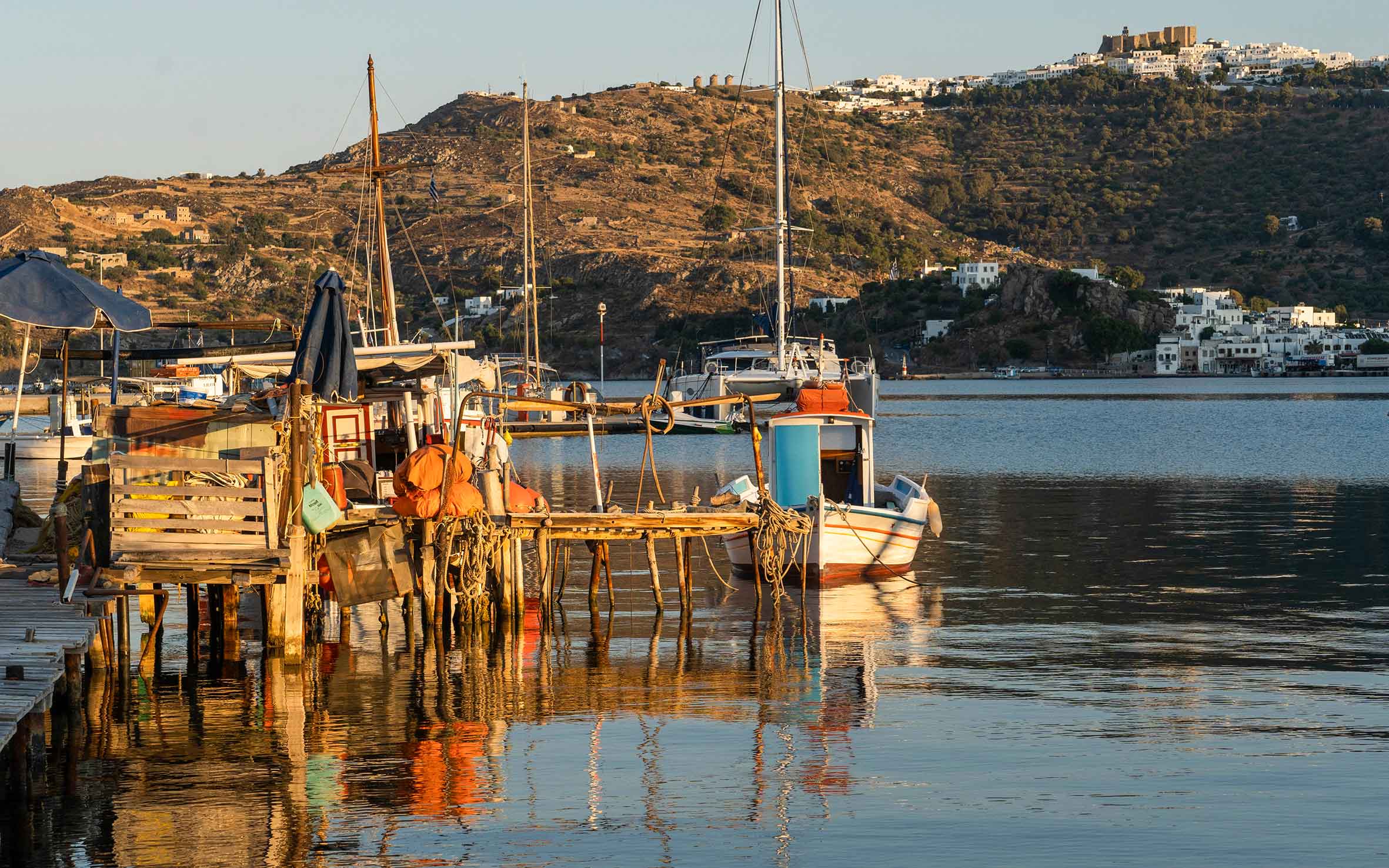
© Perikles Merakos
A story from the old times
The visitor I am going to meet is an English financier who is interested in buying a property on the island. He has friends who have done so already, and more importantly, is a Byzantine history buff. The choice of Patmos, he explains to me later, was a no-brainer. As we wait for his hire car, he reminds me of the laws of real estate. The best locations have been selected for the gods, as places of worship. Second come soldiers, for obvious strategic reasons of command and control. Third come the artists, who have an eye for pleasing places. Fourth – and he points to himself – the wealthy.
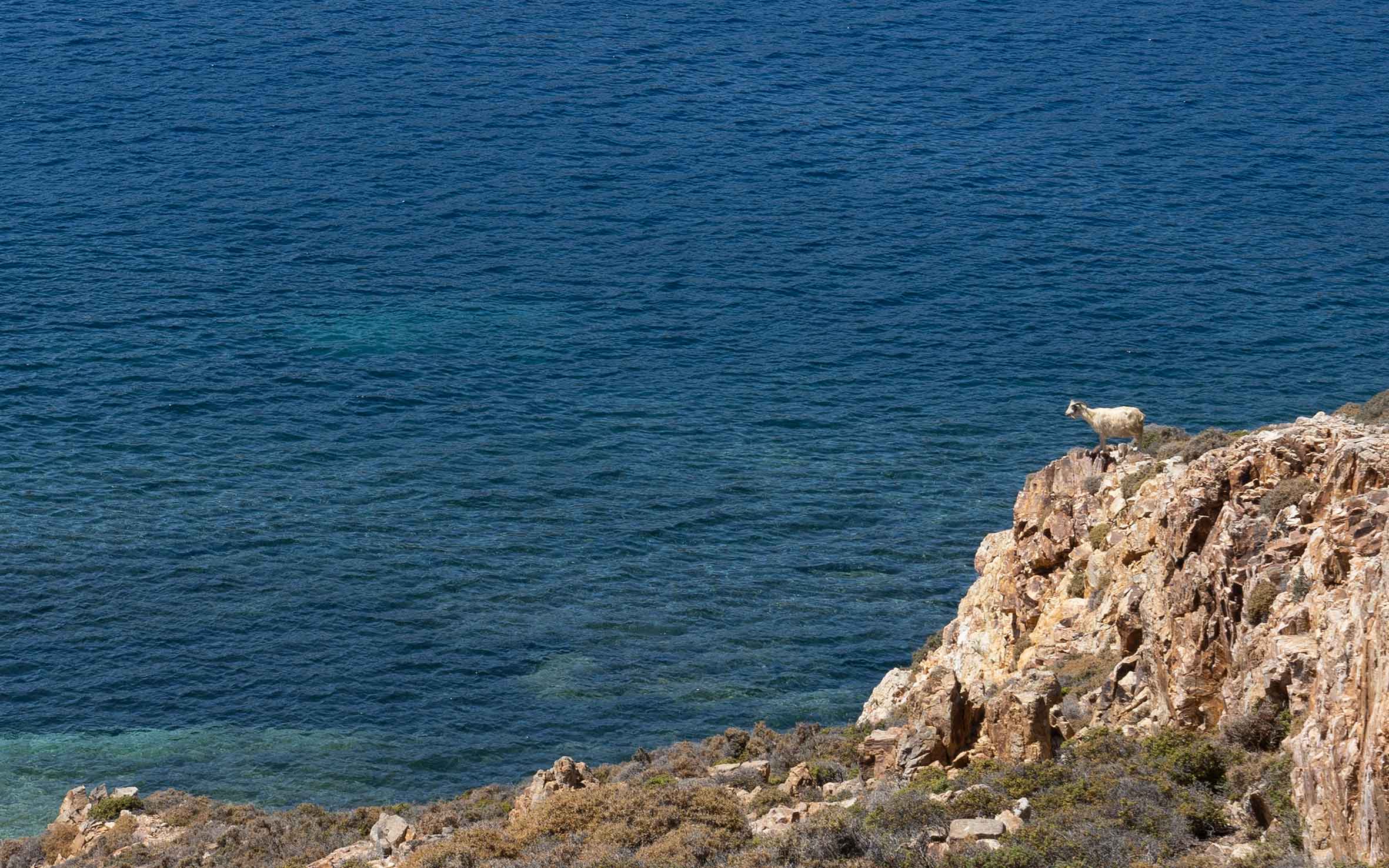
© Darran Rees
I ask him what he planned to do once he had installed himself in his quarters. “First of all, I would like you to take me to the monastery and the Cave of the Revelation.” It is his turn to ask me how long I have been coming to Patmos. “This year it will be 40 years. I first came at the invitation of a classmate in tour guide school, and since then I have been coming back on and off. More recently I have been involved in ‘Patmos 360,’ a rental platform for mansions in Chora, as well as in Sotheby’s Realty Greece, as you well know.”
Our conversation drifts to lighter subjects as we climb towards our destination. We touch on the strife in the British royal family. “I hear Prince Charles has been here?” he comments in the form of a question. “I have a funny story to tell you about that,” I respond.
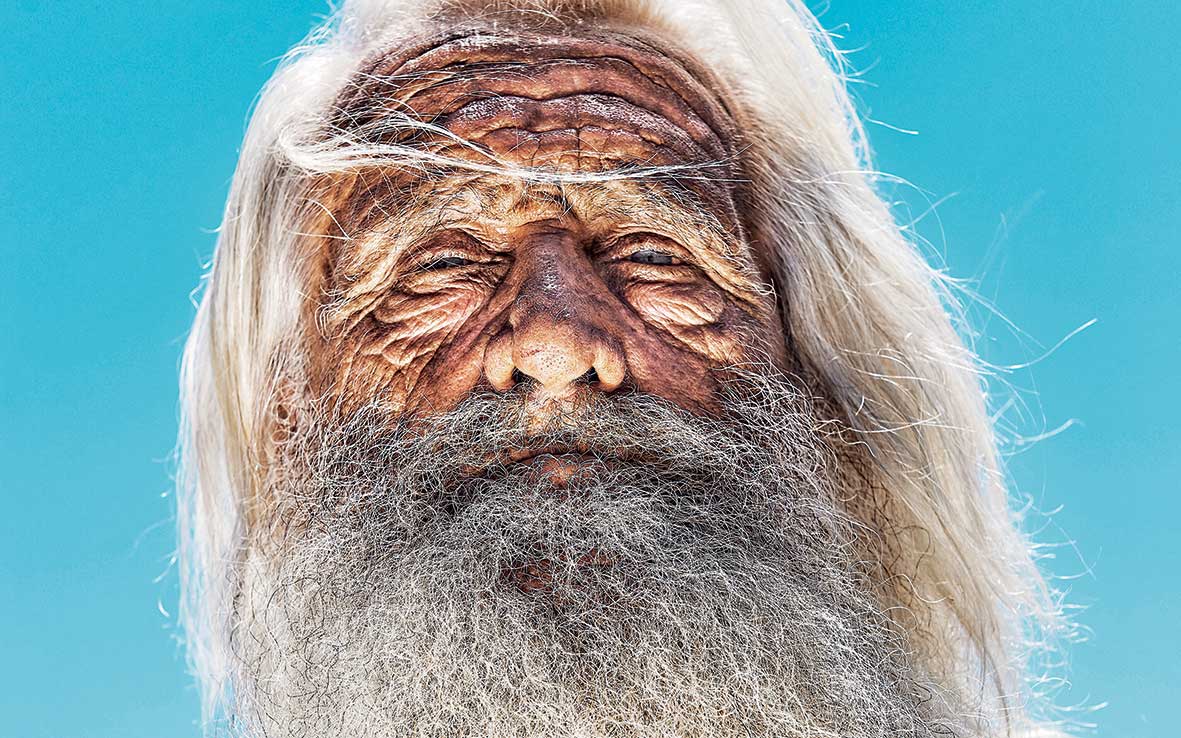
© Darran Rees
“In the mid-1990s, my pregnant French wife and I had rented the house you will be staying in along with a group of friends. On the day we arrived, I asked Prince Michael of Greece, a regular visitor to the island, which remote beach he would recommend for swimming. He suggested Livaditou Geranou. When we arrived there, we discovered we were not alone. A tall, athletic-looking man stood on the beach, while another man, of medium height, reclined on a towel under a beach umbrella reading a book. “Le Prince Charles!” exclaimed my 16-year-old French godson, who also happens to be named Charles. I responded that the heir to the British throne was neither tall nor blond, and nor was he so athletic. “Not the standing man, the one lying down,” he corrected me with great certainty.
Because they were some distance from us – we had discreetly picked a spot further away so as not to crowd them – I was not able to verify this information. When I eventually plucked up the courage to walk over and greet him, I realised that it was indeed him. He was reading a book by the Byzantinologist Sir Steven Runciman, “The Rise and Fall of the Byzantine Empire,” and was kind enough to exchange a few words with me, mainly regarding his cousin Constantine.”
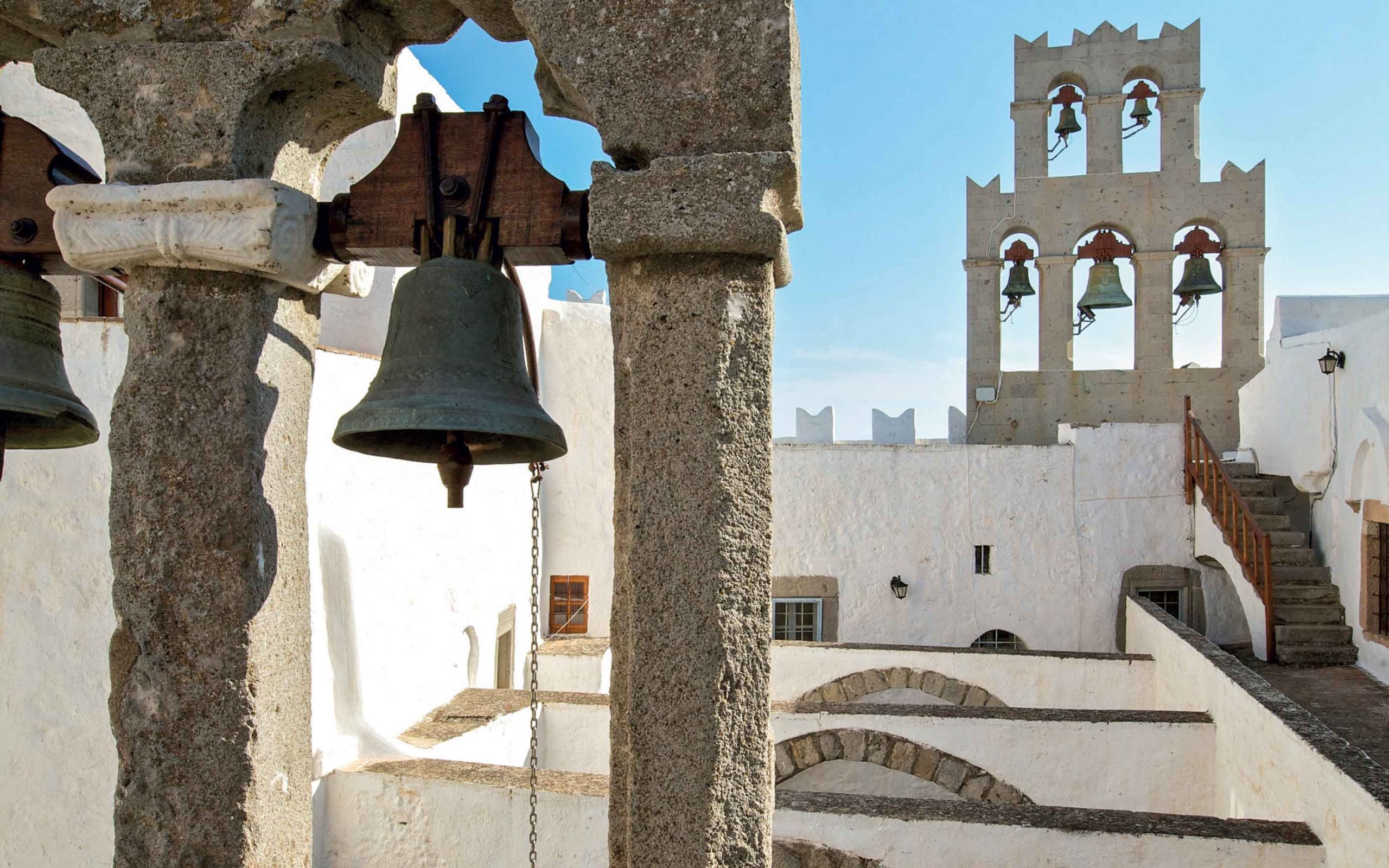
© VisualHellas.gr
The monastery and the Cave of the Revelation
We have reached the Town Hall square, where we park. My guest is drawn to the statue of Emmanuel Xanthos. “This year we are celebrating the 200-year anniversary of the Greek Revolution. This gentleman, who was descended from the island, was one of the prime instigators, as a member of the Filiki Eteria – a secret society founded with the aim of overthrowing Ottoman rule,” I inform him. He stops, and then walks a little further off. “Amazing view. What are those islands?” “To the west is Ikaria, to the north, in the distance, is Samos. To the east is the Arkii complex, and Lipsi.”
Entry to the monastery is free for Greeks, while foreign visitors are charged 6 euros. By good fortune the entrance is not crowded with tour groups. Good fortune also brings Father Theodosios to us in the monastery courtyard. He was a monk on Mount Athos, but got a “transfer” here to reinforce his few remaining colleagues on the island. Although he is now of a certain age, he has boundless energy and a clear gaze, full of kindness.
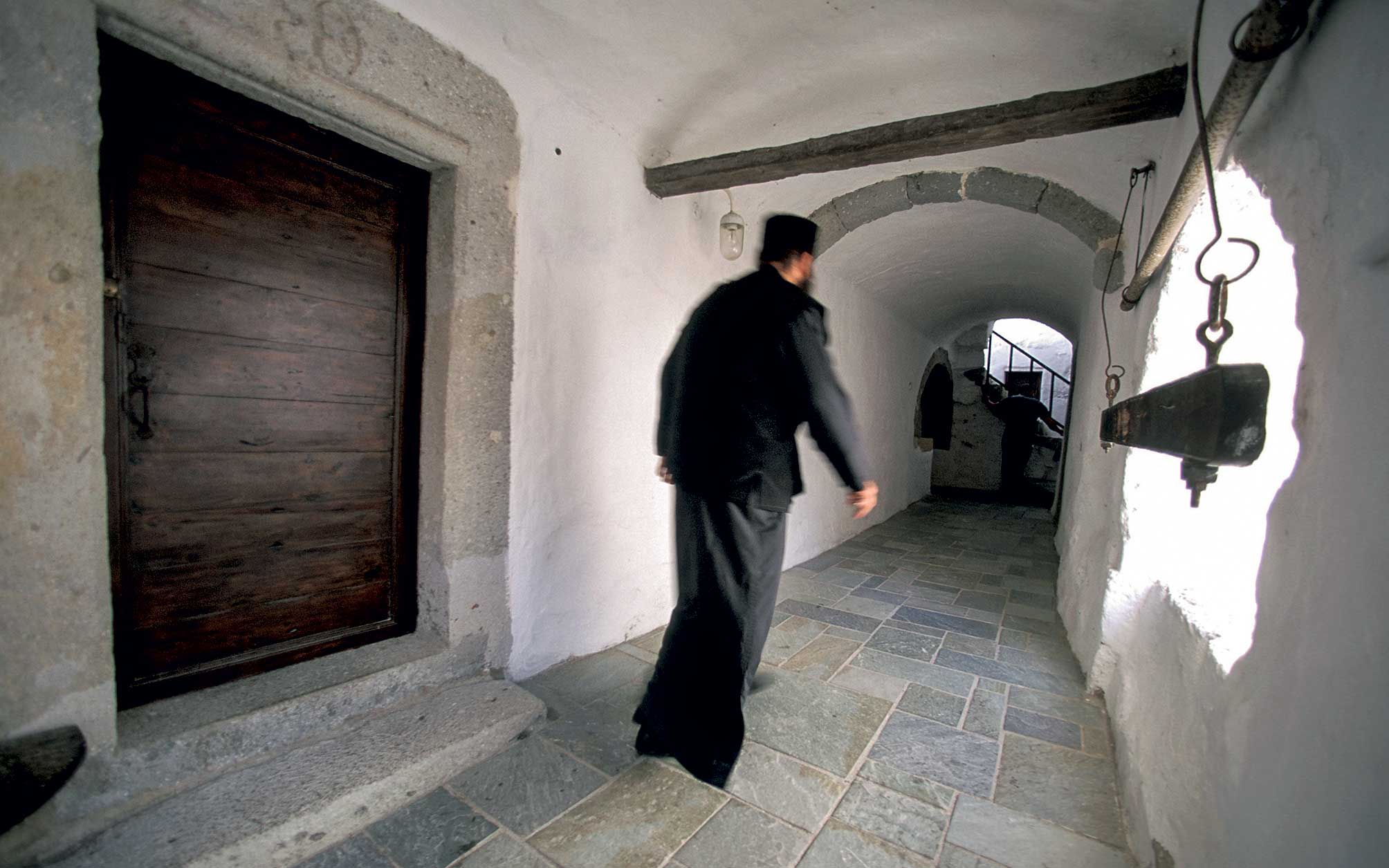
© VisualHellas.gr
We start our tour in the church vestibule. As if reading my English guest’s mind as he looks at the columns, he reveals their origin. They originally belonged to the temple of Artemis, which first occupied the site where the monastery was built. We are stunned by a scene of extreme violence, with young soldiers slaughtering infants with their daggers while the mothers fight to save them – a fresco depicting the biblical massacre of the innocents by King Herod.
The remaining frescoes have a calmer subject matter, such as the parable of the ten virgins. I ask Father Theodosios to show us the “Incredulity of St Thomas.” He politely takes my phone and turns on the torch function, illuminating a niche under an arch. Next to it is the “Noli mi tangere” scene from the Bible, in which Mary Magdalene recognised Christ after the resurrection.“Do not touch me,” I translate.
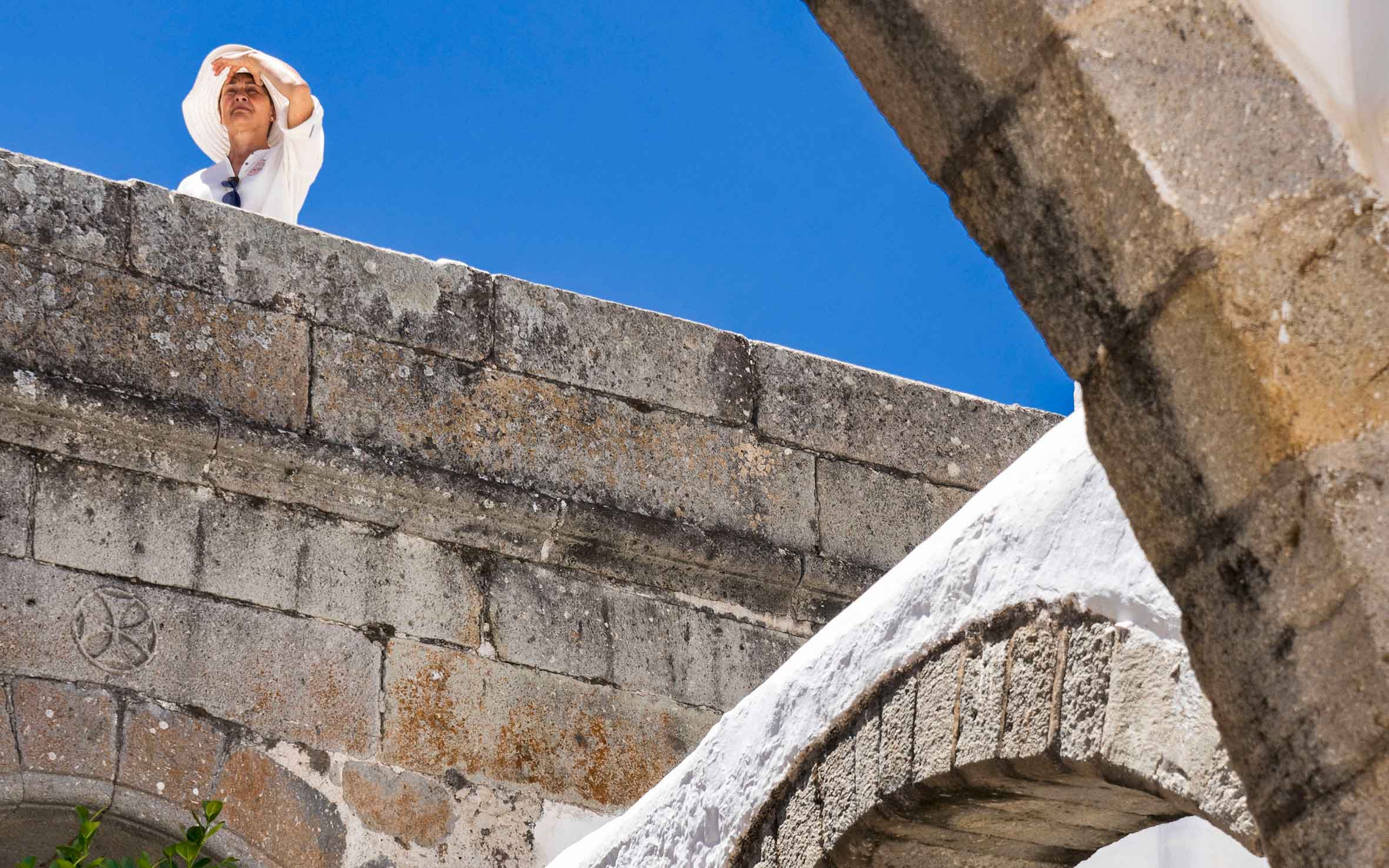
© Perikles Merakos
In the chapel of the Virgin the light is stronger and the art is more robust. The frescoes are Byzantine, and date to the 12th century. Our guide pulls aside a curtain to reveal an icon of the Mother and Child.
John, as is my guest’s name, remains rooted to the spot, ecstatic. The tour continues to the Museum, with its priceless collection of manuscripts, ecclesiastical dress and accoutrements, Byzantine icons – one of which is attributed to El Greco – and antiquities, located on the upper floor. At the end, John asks about the “Clarke Plato.” Father Theodosios tells the story of the English traveller, who, according to one telling of the story, bribed the abbot of the monastery at the time and extracted from him the oldest surviving manuscript of Plato’s Dialogues. Today it graces the collection of the Bodleian Library in Oxford.
Our next stop is the Cave of the Revelation. According to oral tradition, but also the written testimony of St John himself, this is where he heard the voice of God and dictated to his student Prochoros the Holy Book of Revelation. Our host at this global landmark of Christendom is Father Isidoros. For many years he has been the guardian of the Cave, like another Cerberus protecting it from disrespectful tourists.
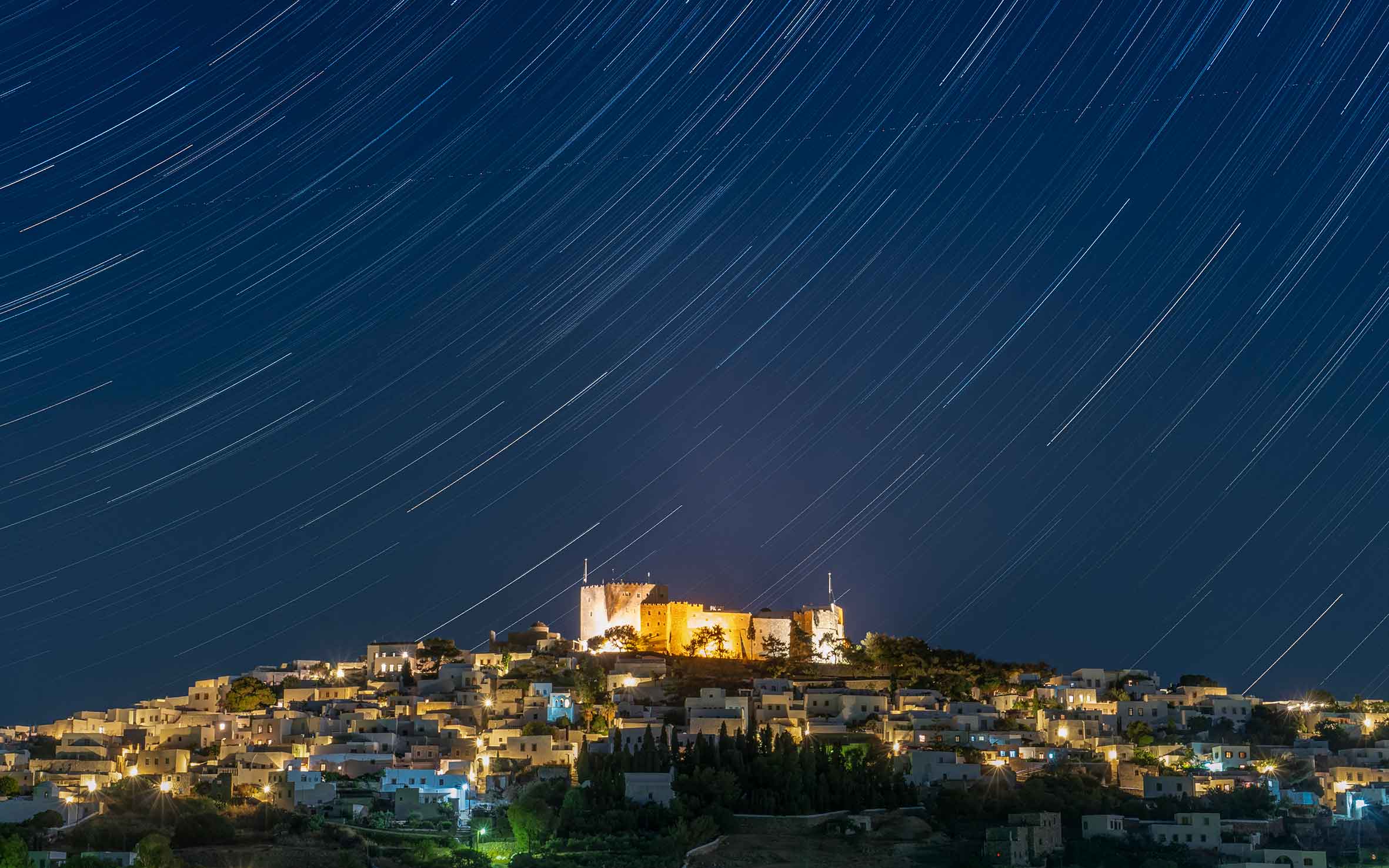
© Perikles Merakos
John’s attention is drawn to an icon depicting the vision of the Revelation on the altarpiece of the 15th century church, but also to three slits in the rock. “Please inform our friend that God spoke to St John in the Greek language, and that St John also wrote it down in Greek,” were the parting words of our monk guide.
“I believe there is also an interesting convent, do you think we should visit?” continues our indefatigable modern traveller. “Hm, I think visiting hours are between 9 and 11 am, so it will be closed now. Let me call the abbess Christonymfi and introduce you. She is a strong personality who is responsible for reviving female monasticism on the island. Thanks to her the convent of the Evaggelismos (Annunciation) is one of the most dynamic and well-looked-after in Greece.”
Having fed our spirits, we returned to material realities. “Do you like chickpeas?” I ask John. “Very much,” he responds. “Great! We will dine at a seaside taverna in the bay of Grikos, where this particular dish will have you licking your fingers.” “Hm, that’s interesting, it sounds good.”
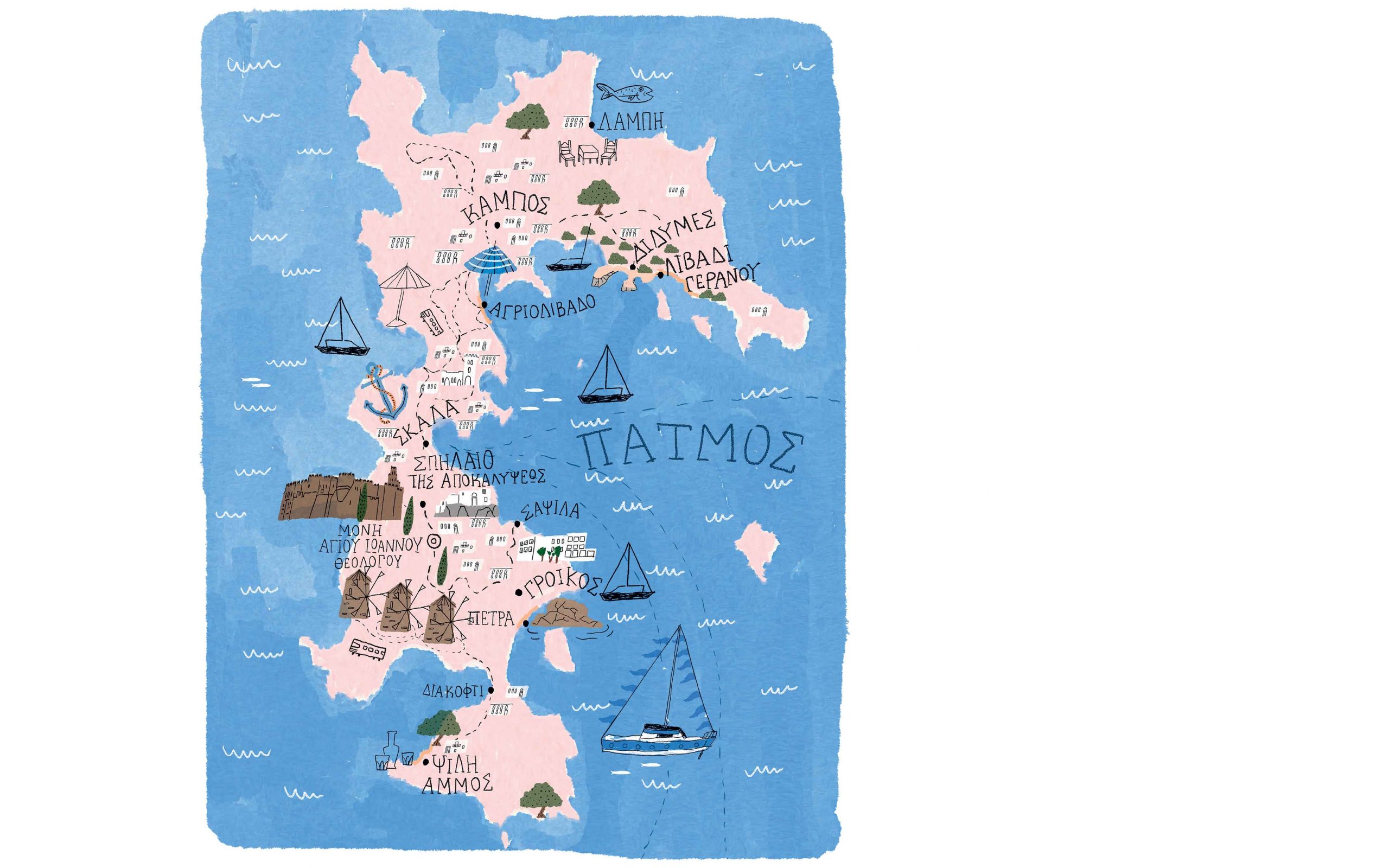
© Illustration: Philippos Avramides
Getting there
Direct from Piraeus with Blue Star Ferries four times a week (from 40 euros one way). Patmos is also connected by sea to Rhodes, Leros, Kalymnos, Samos and Kos, with daily catamaran schedules by Dodekanisos Seaways (Tel. (+30) 22410.70590). The closest island with an airport is Leros. For more information on schedules contact Patmos Port Authority, Tel. (+30) 22470.31231.
Accommodation
The renovated former Xenia Hotel, renamed Patmos Aktis Suites & Spa (Tel. (+30) 22470-32800, from 138 euros for a double room with breakfast) in Grikos, Liginou Studios (Tel. (+30) 6972.697.602, from 150 euros for a double room with breakfast) located on the private beach of the same name at Livadi, the sophisticated Patmos Eye (Tel. (+30) 22470.32698, from 200 to 450 euros with breakfast) in Skala and the Patmos 360 houses (Tel. (+30) 2310.526563, from 5,000 euros a week) in Chora are all safe choices for reliably decent accommodation.
Food
The arrival of Benetou (Tel. (+30) 22470.33089) in Sapsila raised the gastronomic bar for the island, adding a sister establishment in Chora last year. The Lambis fish taverna (Tel. (+30) 22470.31490) on the beach of the same name, Flisvos (Tel. (+30) 22470.31380), and Ktima Petra (Tel. (+30) 22470.33207) in Grikos Bay, Pleiades (Tel. (+30) 22470.33034) in Sapsila, Tarsanas Marine Club (Tel. (+30) 22470.32159) in Diakofti, Trehantiri (Tel. (+30) 22470.34080), Hiliomodi (Tel. (+30) 22470.34179), To Tsipouradio Mas (Tel. (+30) 22470.32803), and Netia (Tel. (+30) 22470.31329) in Skala, as well as the immovable Vaggelis (Tel. (+30) 22470.31967) in Chora, are all interesting propositions.
Coffee & drinks
In the Italianate central square of Skala, people meet at Petrino (Tel. (+30) 22470.31422), Houston (Tel. (+30) 22470.31688), and the historic Arion (Tel. (+30) 22470.31595). In Chora, the dominant choice for morning coffee or afternoon tea is Loza (Tel. (+30) 22470.32405), while in Kampos the perennial choice is George’s Place (Tel. (+30) 22470.31881), which this year will be operating under new management. In the evenings, chic youngsters exchange vows of eternal happiness at Kasbah ([email protected]).
Beaches
Spearheaded by the protected beach at Psili Ammos, Patmos offers a multitude of choices for swimming, from the organized family beaches at Kipos and Agriolivado to the alternative options at Didimi, Livadi, Geranos and Petra.
Christos Zabounis is the author of “Oblation to Patmos”.

